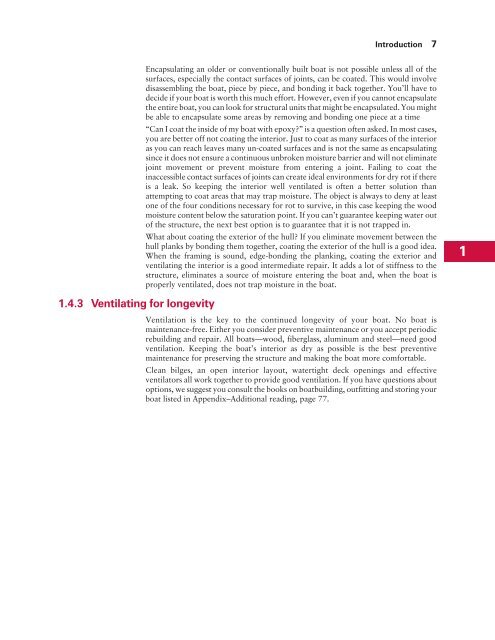Wooden Boat Restoration Repair - WEST SYSTEM Epoxy
Wooden Boat Restoration Repair - WEST SYSTEM Epoxy
Wooden Boat Restoration Repair - WEST SYSTEM Epoxy
Create successful ePaper yourself
Turn your PDF publications into a flip-book with our unique Google optimized e-Paper software.
1.4.3 Ventilating for longevity<br />
Introduction 7<br />
Encapsulating an older or conventionally built boat is not possible unless all of the<br />
surfaces, especially the contact surfaces of joints, can be coated. This would involve<br />
disassembling the boat, piece by piece, and bonding it back together. You’ll have to<br />
decide if your boat is worth this much effort. However, even if you cannot encapsulate<br />
the entire boat, you can look for structural units that might be encapsulated. You might<br />
be able to encapsulate some areas by removing and bonding one piece at a time<br />
“Can I coat the inside of my boat with epoxy?” is a question often asked. In most cases,<br />
you are better off not coating the interior. Just to coat as many surfaces of the interior<br />
as you can reach leaves many un-coated surfaces and is not the same as encapsulating<br />
since it does not ensure a continuous unbroken moisture barrier and will not eliminate<br />
joint movement or prevent moisture from entering a joint. Failing to coat the<br />
inaccessible contact surfaces of joints can create ideal environments for dry rot if there<br />
is a leak. So keeping the interior well ventilated is often a better solution than<br />
attempting to coat areas that may trap moisture. The object is always to deny at least<br />
one of the four conditions necessary for rot to survive, in this case keeping the wood<br />
moisture content below the saturation point. If you can’t guarantee keeping water out<br />
of the structure, the next best option is to guarantee that it is not trapped in.<br />
What about coating the exterior of the hull? If you eliminate movement between the<br />
hull planks by bonding them together, coating the exterior of the hull is a good idea.<br />
When the framing is sound, edge-bonding the planking, coating the exterior and<br />
ventilating the interior is a good intermediate repair. It adds a lot of stiffness to the<br />
structure, eliminates a source of moisture entering the boat and, when the boat is<br />
properly ventilated, does not trap moisture in the boat.<br />
Ventilation is the key to the continued longevity of your boat. No boat is<br />
maintenance-free. Either you consider preventive maintenance or you accept periodic<br />
rebuilding and repair. All boats—wood, fiberglass, aluminum and steel—need good<br />
ventilation. Keeping the boat’s interior as dry as possible is the best preventive<br />
maintenance for preserving the structure and making the boat more comfortable.<br />
Clean bilges, an open interior layout, watertight deck openings and effective<br />
ventilators all work together to provide good ventilation. If you have questions about<br />
options, we suggest you consult the books on boatbuilding, outfitting and storing your<br />
boat listed in Appendix–Additional reading, page 77.<br />
1
















